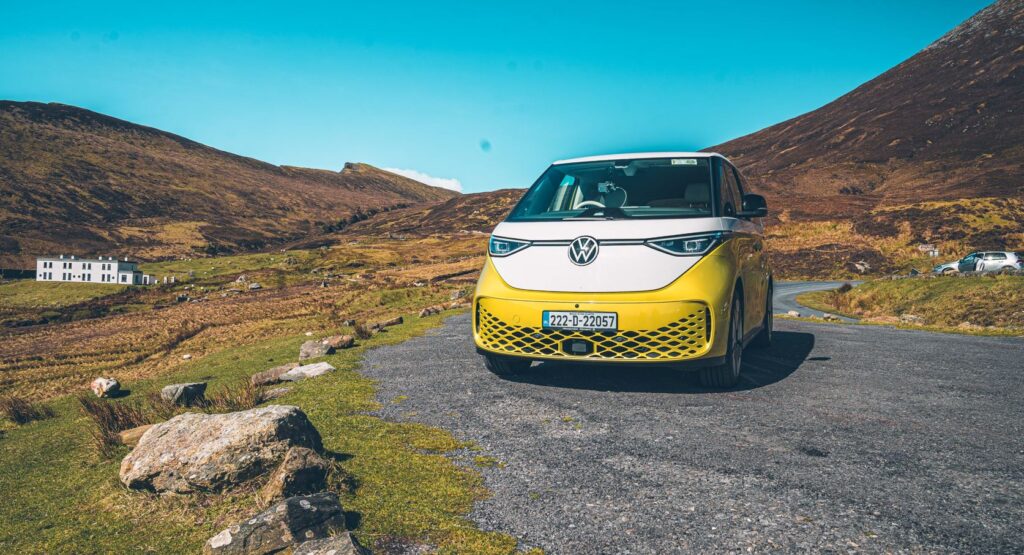To test the ID Buzz, we took it on a road trip out to the remote parts of the West of Ireland. In Co. Mayo there are plenty of winding roads with epic scenery to match, but what there aren’t so many of us electric chargers. 1000 KM’s in an electric van, namely Volkswagen’s ID Buzz, with a WLTP range of just over 400 KM’s.
The design is so futuristic that it puts a lot of modern cars in the shade, it’s very close to the concept designs too. It’s an exciting departure from the norm and on a recent trip out to Mayo and the remote Achill island, we were able to prove that it’s possible to do a 1,000 km trip in the Buzz.
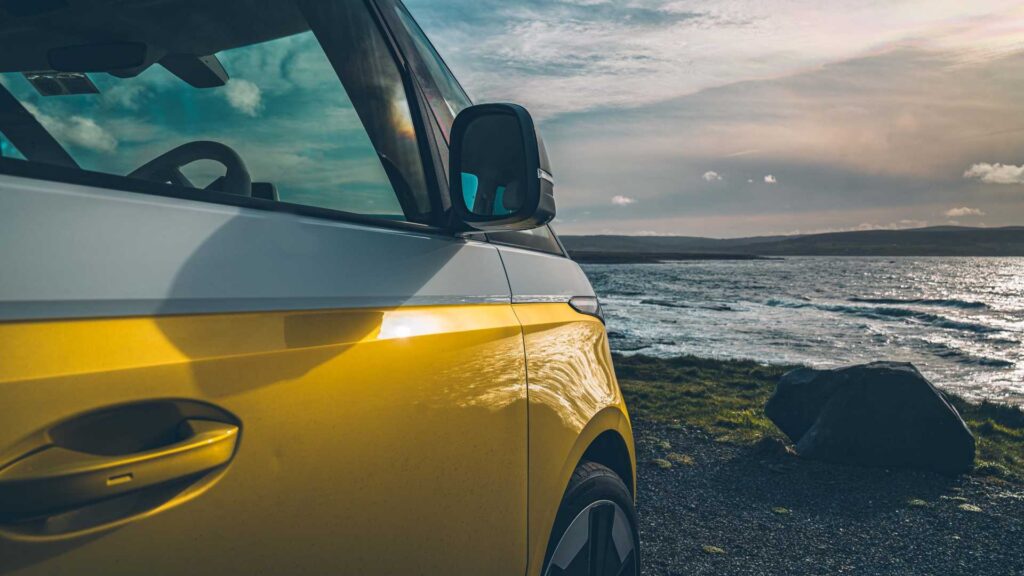
Special mention : Quick top up charge (when using 50 kWh charger). Loads of space, great comfort for 5 and brilliant visibility. Sliding doors make access easy. People wave and smile at you a lot.
Needs work : The light coloured seats are starting to soak up colouring from clothes. Voice Activation starts randomly (it once activated on a cough). Full WLTP range wasn’t achieved. Stereo struggles with podcasts at motorway speeds. Big boot door can hinder reversing into spots to charge, if your cables are stored in the boot.
| BHP 204 BHP | Electric / Auto |
| 0-100 km/h in 7.3 seconds | Road Tax €120 |
| Price: from €68,470 As Spec’d : €78,515 | Boot Space 1,211 – 2,205 litres |
The ID. Buzz is based on the brand’s MEB platform, which has been designed specifically for pure-electric cars. It’s already used in several VW Group models, including the Audi Q4 e-tron, Cupra Born, Skoda Enyaq iV and VW ID.3 and ID.4.
Following the familiar face, the ID. Buzz has a full-width LED light bar sitting above the blanked-off front grille. Beneath this, the front bumper has hexagonal air intakes running the full width of the nose. Around the back is a slim LED tail light design and a full-width light bar. Like the other VW ID. models, the charging port is located in the lower part of the rear quarter panel near the bumper.
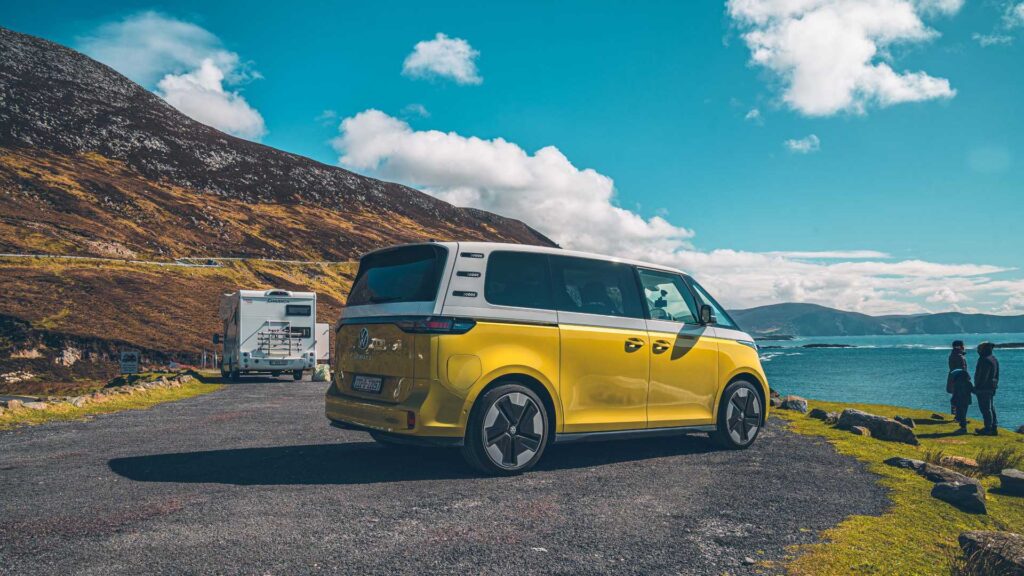
The 204bhp single-electric motor setup from the ID.3 and ID.4 is available on the 77kWh battery version and in this guise, a range of around 400 kms is given by the manufacturer. Using varying charging stations along our 1,000 km route we saw an increase in range available but we didn’t reach the dizzying heights of 400 + kms. Rapid charging is possible with speeds of up to 135kW. This would mean a 10-80% charge takes around half an hour (we haven’t been able to test this anywhere ourselves yet), while a full recharge from a 7kW home wallbox takes around 8 hours. Using the 50kW ESB chargers along our route, we found a top up from 50% to full was possible in just over an hour.
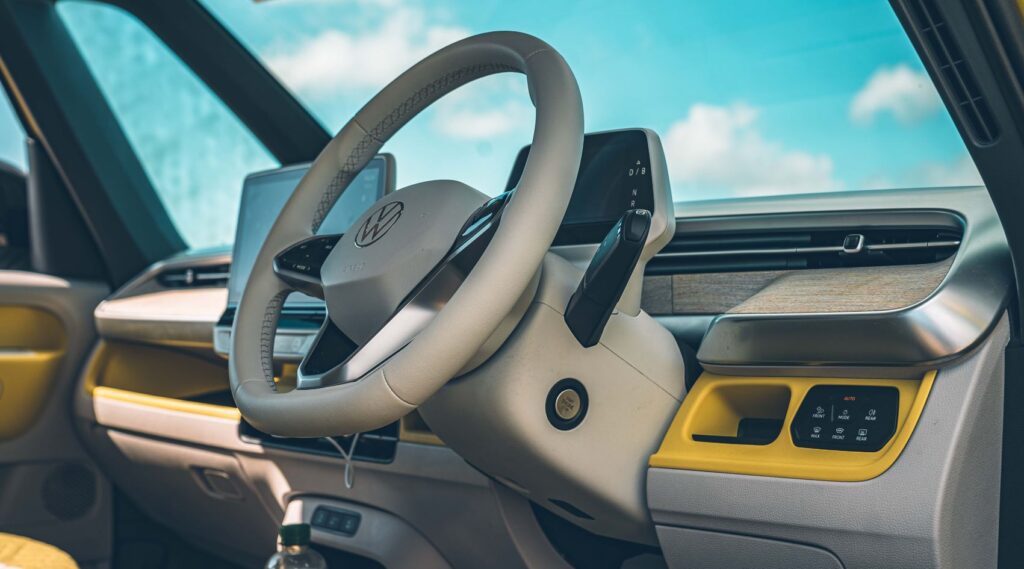
The ID. Buzz is based on a van style box shape and also comes as a Combi. So with sliding rear doors and a high roof, access to the back seats is really easy for families. This makes fitting and manoeuvring of child seats & their occupants easy. However, the ID. Buzz only comes with two sets of Isofix child seat attachments on the rear bench. There’s no option yet to add another on the front passenger seat either. There are no air vents for back-seat passengers but the back seat pockets feature a smaller space for phones. There are USB-C sockets which are in the sliding side doors, so you might want to be careful of devices which are plugged in when you go to open the door. There’s plenty of storage around the cabin due to the layout and the flat floor without a transmission tunnel taking up space. The area below the main vents hides the cup holders and there’s storage for smartphones, while the seats themselves have built-in armrests for added comfort. The tall driving position gives the driver a wide open view out front, although the split A-pillars cause issues with visibility at roundabouts or oddly shaped junctions even though you’ve got a few cut outs in the A pillar to see through.
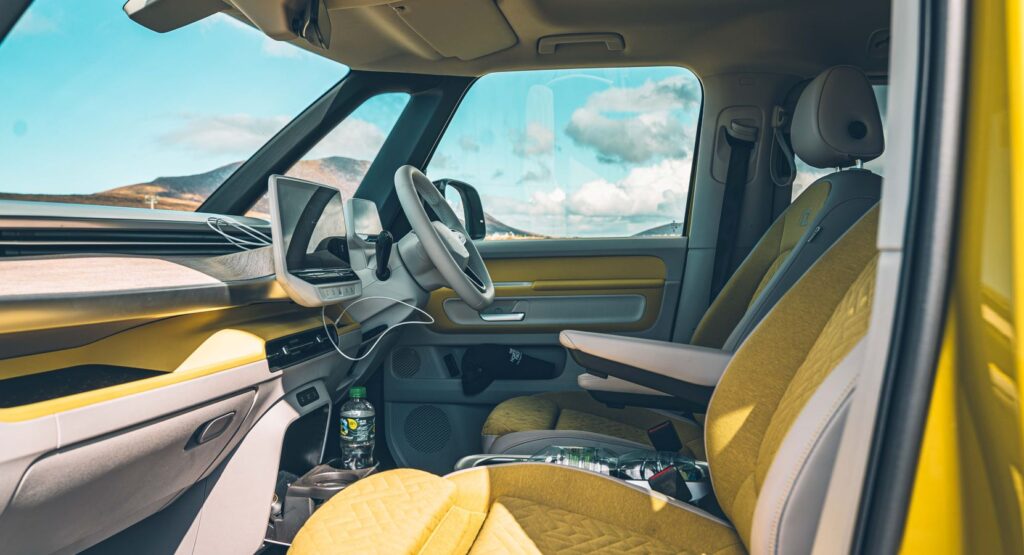
The cargo area is rectangular with mostly flat sides, an extending load bay cover keeps all the cables hidden and comes as standard on the Max. The back seats are fixed in the ID. Buzz and unfortunately can’t be completely removed. The seat backs collapse on top of the seat cushions and they end up leaving a large step down to the boot floor if you don’t have any extras in place to give a flat load bay. The seats can be folded via levers on the sides and the red fabric handles allow access from the rear. VW offers a retractable tow bar with electric release as an option, the towing weights are 750kg unbraked or one tonne braked.
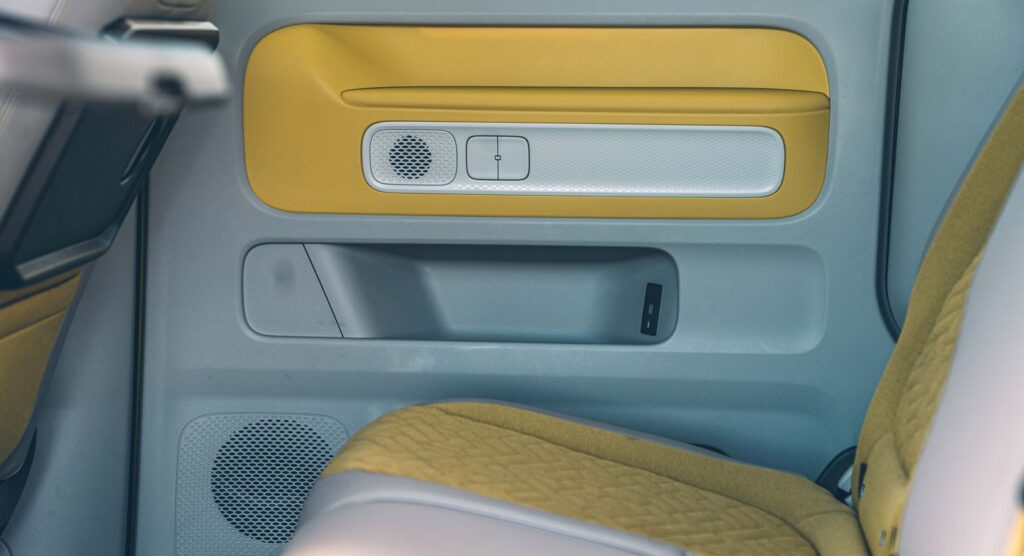
The turning circle is superb, with 11.1 metres it’s superb with maneuvering into and out of tight spots and this magic is all due to the rear-wheel-drive layout. The Buzz is also helped by Park Assist Plus with self-parking function as standard. This manoeuvres the ID. Buzz in and out of spaces automatically, probably most handy for those who have an awkward permanent charging space they use regularly. The tech happens via front and rear sensors and the reversing camera.
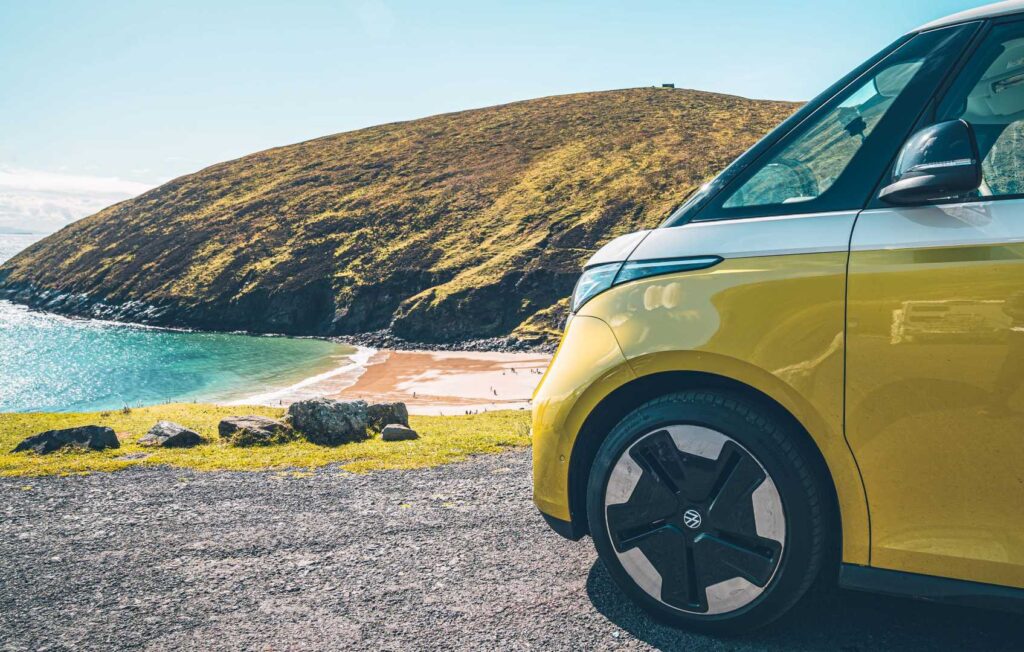
Inside there’s a touchscreen angled towards the driver, with touch-sensitive sliders for controlling the air and infotainment systems (not lit at night). Black plastic trim surrounds the dashboard and light fabric upholstery for the seats. More and more we’re seeing manufacturers use sustainable materials, and here VW doesn’t provide any leather upgrade options. However VW offers a range of brightly coloured seat fabrics and light plastic trim as an optional extra. The light plastics have so far stood up to the daily grind of family life but they are taking a little colouring from clothes also the bright colours give the cabin an extra lift. For an expensive car, you’d assume kit such as a heated steering wheel and seats came as standard but are available only as you go up the trim levels. VW’s 10” Discover Pro system as seen on the ID.3 and ID.4, is fitted as standard, nearly every function is located within the touchscreen. Air-con, volume and temperature controls are all located within a menu.
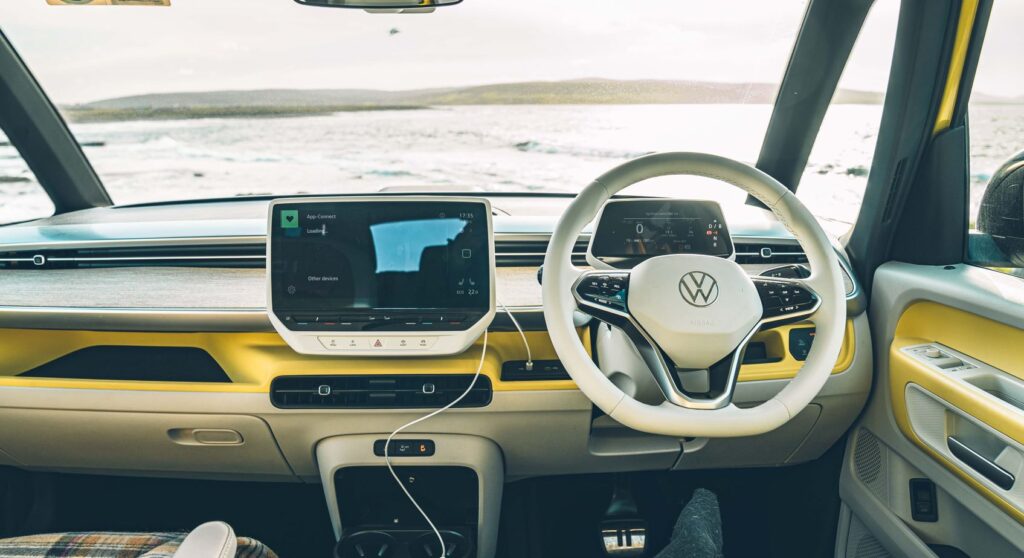
When you need to charge your devices, there’s a number of USB-C sockets dotted around the cabin. Unlike Ferrari’s new Purosangue, VW give you Sat-Nav (handy for when you’re out of mobile coverage) and you can also use the wireless Apple CarPlay and Android Auto.
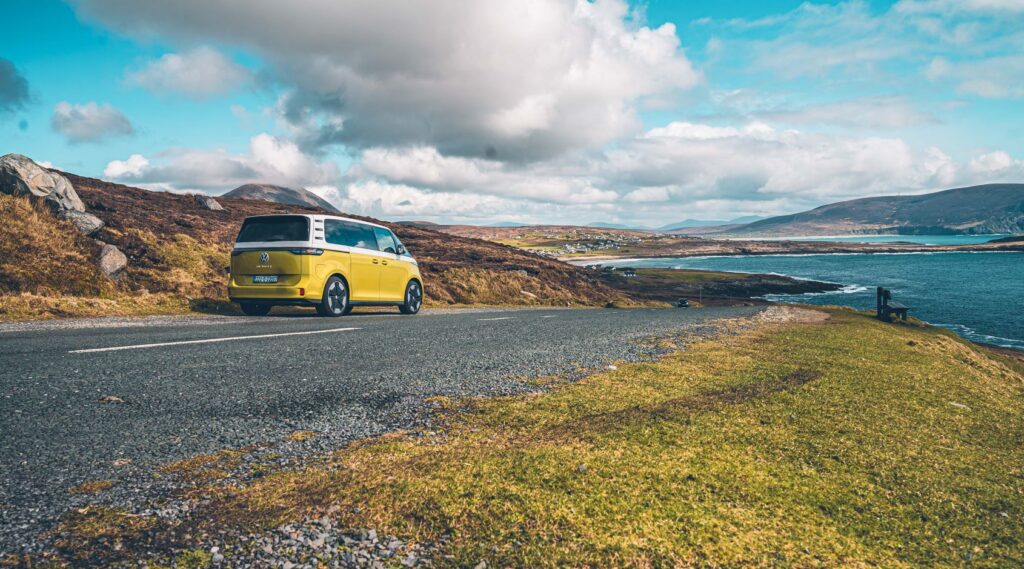
The ID Buzz isn’t cheap, it offers a radical, stand out design and funky looks. They’ve made good use of interior space but could do with a little clever engineering with the insert to give the flat load bay as it’s machined into place and doesn’t look like a simple task to remove. For an adventure lifestyle vehicle it works very well and while a bigger range would be welcomed for, it is possible to do 1,000 kms in the ID. Buzz to remote parts of Ireland.
